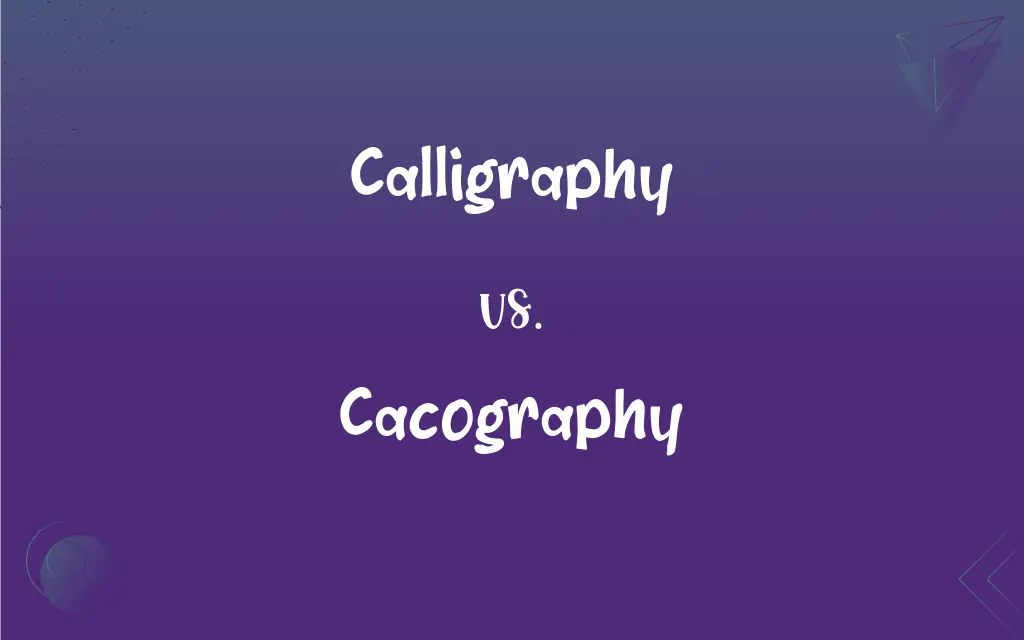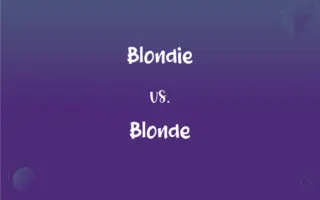Calligraphy vs. Cacography: What's the Difference?
By Janet White || Updated on May 22, 2024
Calligraphy is the art of beautiful, expressive handwriting, whereas cacography refers to bad or illegible handwriting.

Key Differences
Calligraphy is a visual art form that focuses on creating aesthetically pleasing and stylistically expressive letters and words. It is often used in formal documents, art, and invitations. Practitioners of calligraphy pay meticulous attention to the form, flow, and consistency of their strokes. Cacography, on the other hand, denotes poor handwriting that is often difficult to read. This term is typically used to describe writing that lacks clarity and coherence. Unlike calligraphy, which emphasizes beauty and skill, cacography reflects a lack of precision and care.
In calligraphy, tools such as pens with specific nibs, brushes, and specialized inks are used to achieve the desired artistic effect. This contrasts with cacography, where such tools and techniques are irrelevant because the focus is not on aesthetics.
The purpose of calligraphy is to convey both the meaning and visual appeal of the written word, often making the text itself a form of art. Conversely, cacography's main issue is the hindrance it poses to effective communication due to its unreadability.
Comparison Chart
Definition
Art of beautiful handwriting
Poor, illegible handwriting
Purpose
Aesthetic expression and readability
Often unintentional and hard to read
ADVERTISEMENT
Tools
Pens, brushes, specialized inks
Standard writing tools
Skill Level
Requires training and practice
Typically results from lack of training
Use Cases
Formal documents, art, invitations
General writing, often seen in everyday notes
Calligraphy and Cacography Definitions
Calligraphy
Form of expressive writing.
Calligraphy adds a personal touch to handwritten letters.
Cacography
Poor handwriting.
The teacher couldn't read the student's cacography.
ADVERTISEMENT
Calligraphy
Art of producing decorative handwriting.
The wedding invitations were written in elegant calligraphy.
Cacography
Messy and unclear writing.
The doctor’s prescription was written in such cacography that the pharmacist had to call for clarification.
Calligraphy
Artistic lettering technique.
The book cover featured intricate calligraphy.
Cacography
Bad penmanship.
Despite his intelligence, his cacography made his work look careless.
Calligraphy
The art of decorative handwriting.
Cacography
Illegible or sloppy writing.
His notes were a mess of cacography.
Calligraphy
Works in decorative handwriting considered as a group.
Cacography
Unrefined handwriting.
The essay was full of errors and cacography.
Calligraphy
Handwriting.
Cacography
Bad handwriting.
Calligraphy
(uncountable) The art or practice of writing letters and words in a decorative style; the letters and words so written.
Cacography
Bad spelling.
Calligraphy
(countable) Any such style of decorative writing.
Cacography
Bad spelling or punctuation, especially unintuitive spellings considered as a feature of a whole language or dialect.
Calligraphy
(countable) A document written in decorative style.
Cacography
Poor or illegible handwriting.
Calligraphy
Fair or elegant penmanship.
Cacography
Incorrect or bad writing or spelling.
Calligraphy
Beautiful handwriting
Cacography
Poor handwriting
Calligraphy
Beautifully stylized writing.
She practiced calligraphy for hours to perfect her strokes.
Calligraphy
Traditional form of handwriting art.
Calligraphy has a rich history in many cultures.
FAQs
What is calligraphy?
Calligraphy is the art of beautiful, expressive handwriting often used for decorative purposes.
Is calligraphy hard to learn?
Calligraphy requires practice and patience to master its precise strokes and forms.
Can cacography be improved?
Yes, with practice and attention to writing techniques, cacography can be improved.
Does cacography affect academic performance?
Poor handwriting can affect how teachers assess written work due to difficulty in reading.
Are there different styles of calligraphy?
Yes, there are many styles, including Gothic, Italic, and Copperplate.
Is calligraphy popular worldwide?
Calligraphy is practiced and appreciated globally, with different cultures having their own styles.
What does cacography mean?
Cacography refers to poor or illegible handwriting.
What tools are used in calligraphy?
Calligraphy often involves specialized pens, brushes, and inks.
Why is cacography a problem?
Cacography can hinder effective communication due to its illegibility.
Is calligraphy used in modern times?
Yes, calligraphy is used in art, formal documents, and special occasions like weddings.
What is the opposite of calligraphy?
The opposite of calligraphy is cacography, which denotes poor handwriting.
Can calligraphy be therapeutic?
Yes, many find calligraphy to be a calming and meditative activity.
Do schools teach calligraphy?
Some schools include basic calligraphy in art or handwriting classes.
Can anyone do calligraphy?
With dedication and practice, anyone can learn calligraphy.
What causes cacography?
Cacography can result from lack of practice, motor skill issues, or haste.
Can poor handwriting be a sign of a learning disorder?
In some cases, poor handwriting can indicate conditions like dysgraphia, a learning disability that affects writing skills.
Is calligraphy considered art?
Calligraphy is indeed considered a form of visual art.
How can one practice calligraphy?
One can practice calligraphy by using workbooks, attending classes, or following online tutorials.
Does calligraphy have historical significance?
Calligraphy has been significant in history, particularly in religious and literary texts.
Can technology help with cacography?
Yes, digital tools and handwriting apps can help improve poor handwriting.
About Author
Written by
Janet WhiteJanet White has been an esteemed writer and blogger for Difference Wiki. Holding a Master's degree in Science and Medical Journalism from the prestigious Boston University, she has consistently demonstrated her expertise and passion for her field. When she's not immersed in her work, Janet relishes her time exercising, delving into a good book, and cherishing moments with friends and family.































































